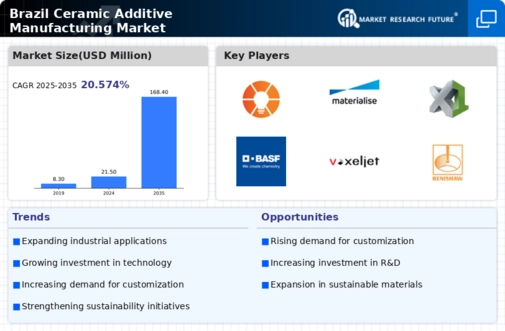The Brazil Ceramic Additive Manufacturing Market is witnessing dynamic changes driven by technological advancements, evolving customer preferences, and competitive strategies among key players. This market has gained traction due to the growing demand for custom ceramic components in various sectors, including aerospace, automotive, and consumer goods. As companies strive to enhance their positioning, the competitive landscape is characterized by innovation, partnerships, and a focus on sustainability. The presence of various international as well as local players enriches the market with diverse product offerings, enabling users to access cutting-edge technologies in additive manufacturing.
Furthermore, the evolving regulatory environment and investment in research and development are shaping the future of ceramic additive manufacturing in Brazil, indicating a promising outlook for both existing and new entrants in the industry. EOS has established a significant presence in the Brazil Ceramic Additive Manufacturing Market, leveraging its advanced technology to cater to various industries looking for precision and quality in ceramic components. The company's strength lies in its robust R&D capabilities and a comprehensive understanding of local market needs. EOS has developed tailored solutions that enhance product performance and reduce manufacturing times.
Their commitment to innovation is underscored by a range of proprietary technologies aimed at improving the efficiency of additive manufacturing processes. The Brazil market allows EOS to position itself as a thought leader and pioneer in the ceramic sector, focusing on collaborations with local businesses and academic institutions to foster knowledge sharing and technical advancements. Materialise has also carved out a notable niche in the Brazil Ceramic Additive Manufacturing Market, recognized for its innovative software solutions and 3D printing services tailored to meet specific customer requirements.
The company operates with a strong emphasis on enhancing the user experience through its proprietary software platforms that simplify and optimize the additive manufacturing process. Materialise showcases a varied portfolio of services, including design optimization and advanced data management, aimed at improving the overall manufacturing efficiency for clients in Brazil. The company has experienced growth through strategic partnerships and collaborations, strengthening its market positioning. Their commitment to sustainability and the promotion of eco-friendly practices further reinforces their appeal in Brazil, aligning with the increasing demand for environmentally responsible manufacturing solutions.





















Leave a Comment